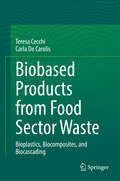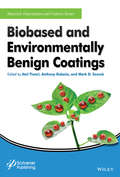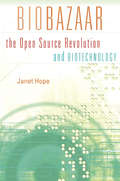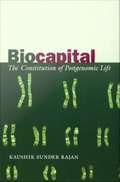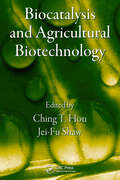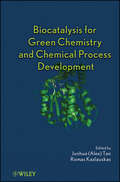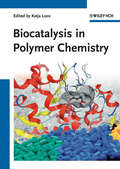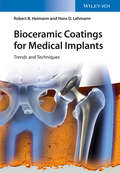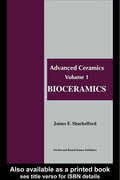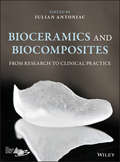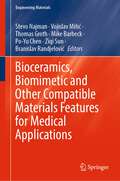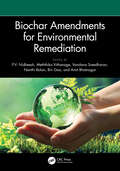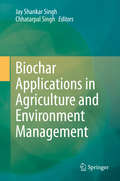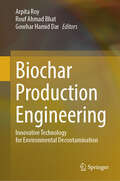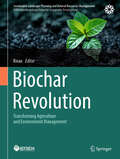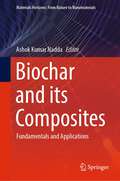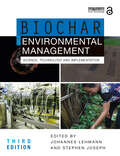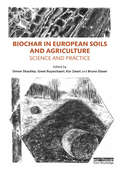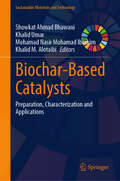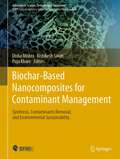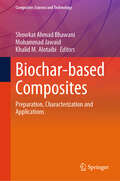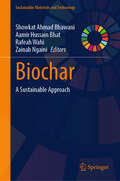- Table View
- List View
Biobased Products from Food Sector Waste: Bioplastics, Biocomposites, and Biocascading
by Teresa Cecchi Carla De CarolisAn increased demand for waste upcycling has prompted the food industry to become more efficient in its handling of waste. Efficient utilization of food waste is of concern to consumers, environmentalists, and policy makers. In the past, food waste has been used for the production of bio-gas and bio-fuels, fertilizers and animal feed. Biobased products from food sector waste: Bioplastics, biocomposites, and biocascading proposes an innovative use of food waste—as filler in a bioplastic matrix.The upcycling of food industry waste to produce new composites has a number of beneficial features, including (i) avoiding the cost of waste disposal; (ii) reducing bio-based composites price; (iii) avoiding using edible resources as a starting material for bio-based composites (to eliminate competition between biomass use for food, feed, and material use); (iv) producing a non-food bio-based output different from existing outputs (bio-fuels or bio-energy). The production of value-added items supports the development of a circular and sustainable economy in a thriving bio-based sector via the emergence of food value chains.The authors explore the safety of bio-based products. Using an evidence-based approach, they detail the volatile profile of biobased products and underline the absence of priority air pollutants released by fossil plastics, which pose a significant public health threat. The volume also delves into socioeconomic considerations and environmental concerns related to the upcycling of food by-products. Finally, the authors address how advances in digital technology can make food waste upcycling a negative-cost process.
Biobased and Environmentally Benign Coatings
by Atul Tiwari Mark D. Soucek Anthony GalanisThis book will have the recent information on the developments in the emerging field of environmental-friendly coatings. Crucial aspects associtaed with coating research will be presented in form of the indivudual chapters. Close attention will be paid to include essential aspects that are necessary to understand the porperties and applications of the novel materials. Different methods and techniques of synthesis and charcaterization will be detailed as individual chapters. It will also discuss the characterization techniques used in the area of such coatings. there will be chapters that descirbe the current status and future prospects. The topics will be selected so they are easy to understand and useful to new scholars as well as advanced learners. No book has been written on this subject so far.
Biobazaar: The Open Source Revolution and Biotechnology
by Janet HopeFighting disease, combating hunger, preserving the balance of life on Earth: the future of biotechnological innovation may well be the future of our planet itself. And yet the vexed state of intellectual property law—a proliferation of ever more complex rights governing research and development—is complicating this future. At a similar point in the development of information technology, “open source” software revolutionized the field, simultaneously encouraging innovation and transforming markets. The question that Janet Hope explores in Biobazaar is: can the open source approach do for biotechnology what it has done for information technology? Her book is the first sustained and systematic inquiry into the application of open source principles to the life sciences. The appeal of the open source approach—famously likened to a “bazaar,” in contrast to the more traditional “cathedral” style of technology development—lies in its safeguarding of community access to proprietary tools without discouraging valuable commercial participation. Traversing disciplinary boundaries, Hope presents a careful analysis of intellectual property-related challenges confronting the biotechnology industry and then paints a detailed picture of “open source biotechnology” as a possible solution. With insights drawn from interviews with Nobel Prize–winning scientists and leaders of the free and open source software movement—as well as company executives, international policymakers, licensing experts, and industry analysts—her book suggests that open source biotechnology is both desirable and broadly feasible—and, in many ways, merely awaiting its moment.
Biocapital: The Constitution of Postgenomic Life
by Kaushik Sunder RajanBiocapital is a major theoretical contribution to science studies and political economy. Grounding his analysis in a multi-sited ethnography of genomic research and drug development marketplaces in the United States and India, Kaushik Sunder Rajan argues that contemporary biotechnologies such as genomics can only be understood in relation to the economic markets within which they emerge. Sunder Rajan conducted fieldwork in biotechnology labs and in small start-up companies in the United States (mostly in the San Francisco Bay area) and India (mainly in New Delhi, Hyderabad, and Bombay) over a five-year period spanning 1999 to 2004. He draws on his research with scientists, entrepreneurs, venture capitalists, and policymakers to compare drug development in the two countries, examining the practices and goals of research, the financing mechanisms, the relevant government regulations, and the hype and marketing surrounding promising new technologies. In the process, he illuminates the global flow of ideas, information, capital, and people connected to biotech initiatives. Sunder Rajan's ethnography informs his theoretically sophisticated inquiry into how the contemporary world is shaped by the marriage of biotechnology and market forces, by what he calls technoscientific capitalism. Bringing Marxian theories of value into conversation with Foucaultian notions of biopolitics, he traces how the life sciences came to be significant producers of both economic and epistemic value in the late twentieth century and early twenty-first.
Biocatalysis and Agricultural Biotechnology
by Ching T. Hou Jei-Fu ShawWorldwide energy and food crises are spotlighting the importance of bio-based products - an area many are calling on for solutions to these shortages. Biocatalysis and Agricultural Biotechnology encapsulates the cutting-edge advances in the field with contributions from more than 50 international experts comprising sectors of academia, industry, an
Biocatalysis for green chemistry and chemical process development
by Junhua Alex Tao Romas KazlauskasThis book describes recent progress in enzyme-driven green syntheses of industrially important molecules. The first three introductory chapters overview recent technological advances in enzymes and cell-based transformations, and green chemistry metrics for synthetic efficiency. The remaining chapters are directed to case studies in biotechnological production of pharmaceuticals (small molecules, natural products and biologics), flavors, fragrance and cosmetics, fine chemicals, value-added chemicals from glucose and biomass, and polymeric materials. The book is aimed to facilitate the industrial applications of this powerful and emerging green technology, and catalyze the advancement of the technology itself.
Biocatalysis in Polymer Chemistry
by Katja LoosSearching for green and environmentally friendly polymerization methods by using enzymes? This first handbook on this hot and essential topic contains the whole chain of knowledge of biocatalysis in polymer chemistry in both a comprehensive and compact form. International leading experts cover all important aspects, from enzymatic monomer synthesis to polymer modification and degradation. While the major focus of the book is on enzymatic polymerizations of the polymer classes reported so far, industrial contributions are also included, making this invaluable reading for biochemists and polymer chemists working in academia and industry.
Biocatalysis: Enzymatic Basics and Applications
by Mohammad Fahad Ullah Qayyum HusainThis book introduces readers to industrially important enzymes and discusses in detail their structures and functions, as well as their manifold applications. Due to their selective biocatalytic capabilities, enzymes are used in a broad range of industries and processes. The book highlights selected enzymes and their applications in agriculture, food processing and discoloration, as well as their role in biomedicine. In turn, it discusses biochemical engineering strategies such as enzyme immobilization, metabolic engineering, and cross-linkage of enzyme aggregates, and critically weighs their pros and cons. Offering a wealth of information, and stimulating further research by presenting new concepts on enzymatic catalytic functions in basic and applied contexts, the book represents a valuable asset for researchers from academia and industry who are engaged in biochemical engineering, microbiology and biotechnology.
Bioceramic Coatings for Medical Implants
by Robert B. Heimann Hans D. LehmannReflecting the progress in recent years, this book provides in-depth information on the preparation, chemistry, and engineering of bioceramic coatings for medical implants. It is authored by two renowned experts with over 30 years of experience in industry and academia, who know the potentials and pitfalls of the techniques concerned.Following an introduction to the principles of biocompatibility, they present the structures and properties of various bioceramics from alumina to zirconia. The main part of the work focuses on coating technologies, such as chemical vapor deposition, sol-gel deposition and thermal spraying. There then follows a discussion of the major interactions of bioceramics with bone or tissue cells, complemented by an overview of the in-vitro testing methods of the biomineralization properties of bioceramics. The text is rounded off by chapters on the functionalization of bioceramic coatings and a look at future trends.As a result, the authors bring together all aspects of the latest techniques for designing, depositing, testing, and implementing improved and novel bioceramic coating compositions, providing a full yet concise overview for beginners and professionals.
Bioceramic Materials in Clinical Endodontics
by Josette Camilleri Saulius DrukteinisThis book focuses on hydraulic calcium silicate-based materials available in clinical dentistry, used as pulp capping materials, root canal sealers, root-end fillers, or root repair materials and which offer improved properties and easier clinical application compared with the original mineral trioxide aggregate. The book introduces the current classification of bioceramic materials and explains their characterization and their physicochemical and biological properties. Thereafter, the various clinical applications of these materials are discussed in depth with reference to the evidence base. The coverage includes applications in endodontic treatments and complications, traumatic dental injuries, management of the vital pulp in both dentitions, and regenerative endodontic procedures. Apart from presenting the latest research on hydraulic calcium silicate-based materials, Bioceramic Materials in Clinical Endodontics promotes an essential balance between basic laboratory and clinical research. It will thus be an important reference for materials science specialists, clinical researchers, and clinicians.
Bioceramics
by James F. ShackelfordThe main sections/chapters of the book focus on the composition of nine types of bioceramics, other simple oxides and more and the medical applications of these materials in orthopaedics, dentistry and the treatment of cancerous tumors.
Bioceramics and Biocomposites: From Research to Clinical Practice
by Iulian AntoniacProvides comprehensive coverage of the research into and clinical uses of bioceramics and biocomposites Developments related to bioceramics and biocomposites appear to be one the most dynamic areas in the field of biomaterials, with multiple applications in tissue engineering and medical devices. This book covers the basic science and engineering of bioceramics and biocomposites for applications in dentistry and orthopedics, as well as the state-of-the-art aspects of biofabrication techniques, tissue engineering, remodeling, and regeneration of bone tissue. It also provides insight into the use of bionanomaterials to create new functionalities when interfaced with biological molecules or structures. Featuring contributions from leading experts in the field, Bioceramics and Biocomposites: From Research to Use in Clinical Practice offers complete coverage of everything from extending the concept of hemopoietic and stromal niches, to the evolution of bioceramic-based scaffolds. It looks at perspectives on and trends in bioceramics in endodontics, and discusses the influence of newer biomaterials use on the structuring of the clinician’s attitude in dental practice or in orthopedic surgery. The book also covers such topics as biofabrication techniques for bioceramics and biocomposites; glass ceramics: calcium phosphate coatings; brain drug delivery bone substitutes; and much more. Presents the biggest trends in bioceramics and biocomposites relating to medical devices and tissue engineering products Systematically presents new information about bioceramics and biocomposites, developing diagnostics and improving treatments and their influence on the clinicians' approaches Describes how to use these biomaterials to create new functionalities when interfaced with biological molecules or structures Offers a range of applications in clinical practice, including bone tissue engineering, remodeling, and regeneration Delineates essential requirements for resorbable bioceramics Discusses clinical results obtained in dental and orthopedic applications Bioceramics and Biocomposites: From Research to Use in Clinical Practice is an excellent resource for biomaterials scientists and engineers, bioengineers, materials scientists, and engineers. It will also benefit mechanical engineers and biochemists who work with biomaterials scientists.
Bioceramics, Biomimetic and Other Compatible Materials Features for Medical Applications (Engineering Materials)
by Po-Yu Chen Ziqi Sun Stevo Najman Vojislav Mitić Thomas Groth Mike Barbeck Branislav RandjelovićThis book reports on advanced biomaterials such as bioceramics, hydrogels, biopolymers, nanomaterials, membranes, and other compatible materials for medical applications. It introduces materials as bioactive coatings that utilize or mimic natural mechanisms and structures important for tissue and organ healing and repair. One section of the book is devoted to bone substitutes and osteogenic biomaterials. It also describes biomaterial-cell-tissue interactions, which are of critical importance for various applications in regenerative medicine, orthopedics, and implant functions. The chapters present fabrication methods and testing of various materials for medical applications. Special emphasis is given to natural patterns, theoretical models, and new insights into material characterization, particularly on fractal natural boundaries and mimicry designs taken from nature and implemented in photonics science and engineering. This multidisciplinary book is written by leading researchers and experts in their fields, and serves researchers, students, physicians, and engineers.
Biochar Amendments for Environmental Remediation
by Bin Gao Nanthi Bolan Meththika Vithanage P. V. Nidheesh Vandana Sreedharan Amit BhatnagarIn the captivating book Biochar Amendments for Environmental Remediation, readers are invited to explore the critical role of biochar in fostering a cleaner environment through its eco-friendly, cost-effective, and sustainable applications such as removal of diverse pollutants from water and wastewater.With 27 insightful chapters contributed by leading researchers worldwide, this book unravels the complexities of biochar production, its characteristics, and its multifaceted roles in environmental remediation. From pilot-scale production methods to removing heavy metals and micropollutants, this book comprehensively explores biochar’s potential for sustainable environmental protection. Discover the cutting-edge advancements in biochar technology and gain valuable knowledge on its pivotal role in mitigating environmental challenges. Join the global discourse on biochar’s diverse applications, risks, and the future of adsorption-based pollutant removal strategies.Biochar Amendments for Environmental Remediation is aimed at researchers, professionals in environmental engineering, and anyone passionate about environmental stewardship and seeking innovative solutions for a greener and healthier planet. Embark on a journey of discovery and empowerment as you explore the transformative potential of biochar in shaping a sustainable future.
Biochar Applications for Wastewater Treatment
by Yuqing Sun Daniel C W TsangBIOCHAR APPLICATIONS FOR WASTEWATER TREATMENT Comprehensive guide to biochar technology as a novel, cost-effective, and environmentally friendly solution for the treatment of wastewater Biochar Applications for Wastewater Treatment summarizes recent research development on biochar production and emerging applications with a focus on the value-added utilization of biochar technology in wastewater treatment, succinctly summarizing different technologies for biochar production and characterization with an emphasis on feedstock selection and pre-/post- treatment. The text discusses the mechanisms of biochar’s various roles in different functions of wastewater treatment and includes the latest research advances in manufacturing optimization and improvements to update the carbonaceous materials with desirable environmental functionalities. Discussion and case studies are incorporated in treating municipal wastewater, industrial wastewater, agricultural wastewater, and stormwater to illustrate and emphasize the promising prospects of biochar technology in the treatment of various wastewater in actual utilization. Perspectives and future research directions of the emerging biochar technology in wastewater treatment are presented to provide insights for the readers and researchers in biochar application in wastewater treatment. Sample topics covered in Biochar Applications for Wastewater Treatment include: Different technologies for biochar production and characterization Adsorption, biofiltration, anaerobic degradation, sludge dewatering and composting, nutrient recovery, advanced oxidation process, and odor control Removal of pharmaceuticals, personal care products, and emerging contaminants Fate and transport in the environment, and life cycle assessment Biochar Applications for Wastewater Treatment is an essential resource for professionals in environmental engineering/sciences, water and waste management, and sustainable environmental development looking for a comprehensive overview of the subject. The text is also valuable for academics interested in wastewater treatment technologies using biochar as a carbon-negative alternative to conventional materials.
Biochar Applications in Agriculture and Environment Management
by Jay Shankar Singh Chhatarpal SinghThis book provides up-to-date information on biochar use in management of soil health, agriculture productivity, green-house gases, restoration ecology and environment. Biochar application to nutrient deficient and disturbed soils is a viable option which may promotes advances in food safety and food security to human nutrition and overall fundamental research in the agricultural sciences. The book describes in detail how the recalcitrant biochar is able to persist for long periods of time and work as a shelter for soil microbial colonisation and their biomass/numbers. This book also includes contents related to important role of biochar applications in the restoration of contaminated agricultural soils. The book will be of particular interest to students, teachers and researchers in the disciplines.
Biochar Production Engineering: Innovative Technology for Environmental Decontamination
by Rouf Ahmad Bhat Gowhar Hamid Dar Arpita Roy&“Biochar Production Engineering - Innovative Technology for Environmental Decontamination&” covers biochar production from different materials. The book discusses comprehensively the compatibility of biochar for cleaning up contamination from different environments. In addition, the book also reconnoiters various eco-friendly, economical, and aesthetically acceptable biochar-based decontamination technologies. The book alluringly highlights the cutting-edge investigation in this field and provides intriguing data on the biochar application for the treatment of various kinds of pollutants to restore the ecosystem features and consequently reveal newfangled scopes of biochar application. Key Features Provides various methods and strategies for biochar production from different raw materials and their physicochemical properties. Investigation in relation to compatibility of biochar as pollution decontamination tool. Address current trends and challenges related to the biochar production and economic aspects of biochar and its use in pollution remediation.
Biochar Revolution: Transforming Agriculture and Environment Management (Sustainable Landscape Planning and Natural Resources Management)
by KiranThis book gives readers a fundamental understanding of the topic of using biochar to mitigate environmental disturbance, water scarcity, soil degradation, and food security in a sustainable way, as well as an overview of new researchable concerns in the field. Biochar, also referred to as "black carbon," encourages plant growth and soil fertility, reduces the need for fertilizer, and lowers soil loss due to erosion. Biochar is a solid material rich in carbon that is created by heating a variety of organic feedstocks in the absence or with little oxygen. Due to its highly porous nature, biochar serves as a sink for atmospheric CO2 in soil and holds onto water and nutrients in surface soil. In addition to providing numerous environmental benefits, biochar can also enhance soil quality and crop output. By transforming agricultural waste into a potent soil enhancer that stores carbon and improves soil fertility, it is possible to increase food security, stop deforestation, and lessen the need for fertilizer. In order to give comprehensive information and analysis on biochar production technology and its consequences in sustainable agriculture and environment management, the authors set out to consolidate information from several sources into a single volume. Toward scientists, decision-makers, and students working toward global sustainability, this book serves as an essential resource and a representation of fundamental and applied knowledge in the field of biochar production and applications.
Biochar and its Composites: Fundamentals and Applications (Materials Horizons: From Nature to Nanomaterials)
by Ashok Kumar NaddaThe book discusses the commercial applications of biochar and its composites. Biochar prepared from pyrolysis of waste biomass is gaining widespread attention in environmental remediation due to its multifaceted benefits. This book explores these possible applications of biochar in water treatment and removal of pollutants from the contaminated sites. It also emphasizes the role of biochar engineering through different physical and chemical methods to enhance structural and physicochemical properties of biochar such as surface area, porosity and surface functional group. It also focuses on the diverse source of biomass that can be used for biochar production, different methodologies for biochar preparation and biochar engineering for improvement of its properties. Finally, it describes all the applications of biochar that can contribute to environmental remediation and sustainability. Given the contents, the book will be useful for students, researchers and professionals in the area of environmental chemistry and material science.
Biochar for Environmental Management: Science, Technology and Implementation
by Stephen JosephFully revised and updated for its third edition, this book presents the definitive compilation of current knowledge on all aspects of biochar.Research on biochar continues to accelerate as its importance for soil health, climate change mitigation and adoption, and the circular economy becomes more widely acknowledged. This book not only reviews recent advances made in our understanding of biochar properties, behavior, and effects in agriculture, environmental management, and material production, but specifically develops fundamental principles and frameworks of biochar science and application. This third edition has been fully revised and updated to reflect recent developments and growing trends, with important coverage of the application of biochar outside of its traditional soil-based uses, the commercialization of biochar, and its incorporation into policy. This includes brand new chapters on the role of biochar-based materials for environmental remediation, building construction, and animal feed, and a greater discussion of biochar's role in the circular economy, climate change mitigation, and sustainable development. Overall, this book provides a systematic, comprehensive, and global examination of biochar. Written by an international team of academics and professionals, it addresses its uses, production, and management and its broader potential for mitigating climate change and driving forward sustainable development.Edited by two leading figures in the field, Biochar for Environmental Management is essential reading for students, scholars, practitioners, and policymakers interested in biochar and the role it can play in environmental sustainability and global sustainable development.Chapter 16 of this book is freely available as a downloadable Open Access PDF at http://www.taylorfrancis.com under a Creative Commons Attribution-Non Commercial-No Derivatives (CC-BY-NC-ND) 4.0 license.
Biochar in European Soils and Agriculture: Science and Practice
by Simon Shackley Greet Ruysschaert Kor Zwart Bruno GlaserThis user-friendly book introduces biochar to potential users in the professional sphere. It de-mystifies the scientific, engineering and managerial issues surrounding biochar for the benefit of audiences including policy makers, landowners and farmers, land use, agricultural and environmental managers and consultants, industry and lobby groups and NGOs. The book reviews state-of-the-art knowledge in an approachable way for the non-scientist, covering all aspects of biochar production, soil science, agriculture, environmental impacts, economics, law and regulation and climate change policy. Chapters provide ‘hands-on’ practical information, including how to evaluate biochar and understand what it is doing when added to the soil, how to combine biochar with other soil amendments (such as manure and composts) to achieve desired outcomes, and how to ensure safe and effective use. The authors also present research findings from the first coordinated European biochar field trial and summarize European field trial data. Explanatory boxes, infographics and concise summaries of key concepts are included throughout to make the subject more understandable and approachable.
Biochar-Based Catalysts: Preparation, Characterization and Applications (Sustainable Materials and Technology)
by Mohamad Nasir Mohamad Ibrahim Showkat Ahmad Bhawani Khalid Umar Khalid M. AlotaibiThis book reviews comprehensively the field and development of biochar-based catalyst by summarizing fundamental approaches and principles to prepare biochar and biochar-based catalysts and focusing on the main applications of biochar-based catalysts in environmental remediation. Biochar is a low-cost carbonaceous material produced from biomass and is regarded as an economical substitute to the activated carbon. The coverage of book highlights the most exciting applications of biochar-based catalysts in different reactions such as oxidation, reduction, hydrolysis, isomerization, dehydration, etc. The book is useful for the academics and researchers who are interested in the development biochar-based catalysts with background in material science, chemical engineering, environmental engineering and environmental chemistry.
Biochar-Based Nanocomposites for Contaminant Management: Synthesis, Contaminants Removal, and Environmental Sustainability (Advances in Science, Technology & Innovation)
by Rishikesh Singh Disha Mishra Puja KhareThis book helps the readers get a holistic understanding of the emergence of biochar-nanocomposite research. The low and long-term exposure of persistent hazardous pollutants in environment is well known for damaging the water, soil, sediments, and living biota. Thus, it is a crucial step to eliminate these pollutants from environment regimes to prevent the on-site destruction or the transfer into the food chain. Biochar is a carbon-rich solid material generated through pyrolysis of biomass, and currently, it is covering the hotspot in environmental management of pollutants. It is being utilized for the efficient immobilization and sorption of organic pollutants, heavy metals, dyes, improvement of soil redox conditions, aggregate stabilization, photocatalytic degradation, and for carbon sequestration. The fascinating properties like surface area, porous structures, functional groups, and mineral components turn it into suitable candidate for the removal of various class of pollutants from environmental matrices. Different reactions like sorption, reduction, precipitation, solidification, and degradation are mainly responsible for the effective cleaning of xenobiotics from environment through biochar application. However, rapidly evolving contaminants in the environment have made the remediation more complex, expensive, and challenging. In view of these aspects, the modification of biochar through the doping of nanometals/metal oxides/surfactants/ or chemical entities will result in modified biochar with high surface area, more functional entities, improved physical, chemical, thermal, and mechanical characteristics with more adsorptive sites. Inclusion of these exclusive properties can be done through magnetic modification, impregnation of nanometals/ metal oxides/surfactants, amination, acid/base reactions, steam activation, etc. The resulted biochar-based nanocomposites have demonstrated a vital role in remediation of persistent organic pollutants, radionuclei, and heavy metals through the various interaction mechanisms like surface complexation, π–π interaction, electrostatic interaction, hydrogen bonding, Fenton process, and photocatalytic degradation. Currently, advanced research work has been carried out for the designing of modified composites of biochar to achieve maximum removal efficiency, reusability, biotoxicity, and sustainability. Hence, for selective removal of pollutants through designed biochar surface with the focused experimentation toward optimization of feedstocks, process variables, appropriate impregnation of nanomaterials, interaction with secondary pollutants, physical environment, longevity, and regeneration will definitely pave the way for safe and commercial application of biochar-based nanocomposites.
Biochar-based Composites: Preparation, Characterization and Applications (Composites Science and Technology)
by Mohammad Jawaid Showkat Ahmad Bhawani Khalid M. AlotaibiThis book provides solid, quantitative descriptions and reliable guidelines, reflecting the maturation and demand of the field and the development of biochar-based composites. This book summarizes the fundamental approaches and principles to prepare biochar-based composites. This book focuses on some important materials (metal oxide/hydroxide, magnetic, clay minerals, graphene oxide, etc.) used for the production of the composites. The coverage of book highlights the most exciting applications of biochar-based composites in the removal of organic and inorganic contaminants from waste water. The book is useful for the academics and researchers who are interested in the development biochar-based composites with background in material science, chemical engineering, environmental engineering and environmental chemistry.
Biochar: A Sustainable Approach (Sustainable Materials and Technology)
by Aamir Hussain Bhat Rafeah Wahi Showkat Ahmad Bhawani Zainab NgainiThis book highlights the latest research on biochar, a low-cost carbonaceous material produced from biomass, and is regarded as an economical substitute to the activated carbon. The book describes the production and the characteristics of biochar through various techniques/methods such as pyrolysis, gasification, torrefaction, and hydrothermal carbonization of carbonaceous biomass, such as agricultural residues, algal biomass, forest residues, manures, activated sludge, energy crops, digestate at high temperature (300–900 °C) and under O2-limiting conditions. The book also highlights the several unique properties of biochar such as an efficient, cost-effective, and environmentally-friendly material for diverse contaminants removal. The variability in physicochemical properties (e.g., surface area, micro-porosity, and pH) provides an avenue for biochar to maximize its efficacy to targeted applications. This book interests academics working in the development of green and sustainable technology in agricultural engineering, material science, chemical engineering, and environmental science.
